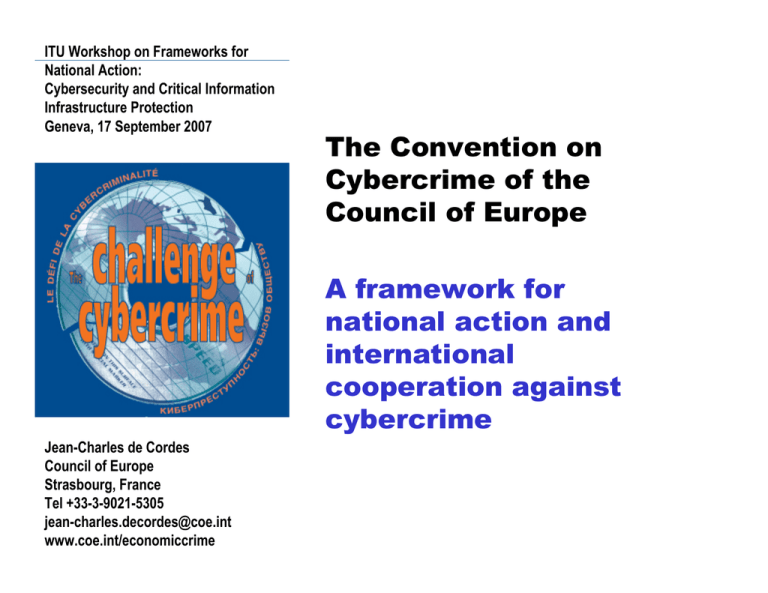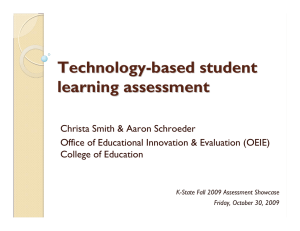
ITU Workshop on Frameworks for
National Action:
Cybersecurity and Critical Information
Infrastructure Protection
Geneva, 17 September 2007
The Convention on
Cybercrime of the
Council of Europe
A framework for
national action and
international
cooperation against
cybercrime
Jean-Charles de Cordes
Council of Europe
Strasbourg, France
Tel +33-3-9021-5305
jean-charles.decordes@coe.int
www.coe.int/economiccrime
1
Council of Europe
1
About the Council of Europe … www.coe.int
Strategy against
economic crime
THE RATIONALE
in order to
promote
Measures against
economic and
organised crime
www.coe.int/economiccrime
democracy
rule of law
human rights
Established in 1949
Currently 47
member States
2
Council of Europe
APPROACH
Setting
standards Convention on
Corruption
Organised crime
Cybercrime (ETS 185)
and Protocol on
Xenophobia and
Racism (ETS 189)
Money laundering
Cybercrime
Monitoring
compliance
Trafficking in human beings
Cybercrime Convention
Committee (T-CY)
www.coe.int/economiccrime
Technical
cooperation
Project on cybercrime
Funded by the Council of Europe
and Microsoft
3
Council of Europe
2
Why take action
against cybercrime?
• Measurable increase in cybercrimes
(phishing, botnets etc)
• More cybercrimes for economic gain
• Increase in hate, racism, violence websites
• Software piracy
• Child pornography
• More organising for cybercrime
• Cyberlaundering
• Cyberterrorism
• Cybercrime: low risk and many opportunities
= Societies around the world highly dependent
on ICT and thus highly vulnerable
In 2007, 1 billion+
Internet users
worldwide.
Even if 99.9%
were legitimate,
this would leave 1
million potential
offenders
Need to balance
fundamental
rights and
freedoms and
concerns for
security
4
www.coe.int/economiccrime
4
Council of Europe
Child pornography on the internet
•
•
•
•
Increasing reporting on child pornography on the internet
Increasing number of commercial sites
Problem: legislative gaps in many countries
Child porn sites hosted in many different countries (see
www.iwf.org.uk)
• Important successes in law enforcement operations
• Law enforcement priority in many European countries
• Public-private cooperation (by ISPs, example CETS)
• Opportunities for enhanced international cooperation
(Convention on Cybercrime)
www.coe.int/economiccrime
5
Council of Europe
Note:
New Convention on the Protection of Children
against Sexual Exploitation and Sexual Abuse
(adopted by CM of the Council of Europe on 13 July 2007 – open
to signature on 25-26 October 2007)
Provisions dealing with:
• Preventive and protective
measures
• Substantive criminal law
• Investigation, prosecution and
procedural law, including childfriendly procedures
• Treatment of sex offenders
• National data base and exchange
of information
• International cooperation
www.coe.int/economiccrime
Parties are to criminalise:
• Sexual abuse of a child
• Child prostitution
• Child pornography
• Participation of a child in
pornographic
performances
• Solicitation of children for
sexual purposes
6
Council of Europe
Note:
New Convention on the Protection of Children
against Sexual Exploitation and Sexual Abuse
(adopted by CM of the Council of Europe on 13 July 2007 – open
to signature on 25-26 October 2007)
Provisions dealing with:
• Preventive and protective
measures
• Substantive criminal law
• Investigation, prosecution and
procedural law, including childfriendly procedures
• Treatment of sex offenders
• National data base and exchange
of information
• International cooperation
www.coe.int/economiccrime
Parties are to criminalise:
• Sexual abuse of a child
• Child prostitution
• Child pornography
• Participation of a child in
pornographic
performances
• Solicitation of children for
sexual purposes
7
Council of Europe
3
Council of Europe
Convention on Cybercrime
(ETS 185)
+
Additional Protocol on racism and xenophobia
committed through computer systems (ETS 189)
8
www.coe.int/economiccrime
8
Council of Europe
The Convention on Cybercrime
¾Elaborated by the Council of Europe with the participation
of Canada, Japan, South Africa and the USA
¾Opened for signature in Budapest in November 2001
¾In force since July 2004
The Protocol on Xenophobia and Racism
Committed through Computer Systems
¾Opened for signature in January 2003
¾In force since March 2006
9
www.coe.int/economiccrime
9
Council of Europe
Structure and content of the Convention
Chapter I: Definitions
(what is a computer system, computer data,
service provider, traffic data)
Chapter II: Measures at national level
Section 1 - Substantive criminal law
(behaviour that is to be made a criminal offences)
Section 2 - Procedural law
(measures for more effective investigations of cybercrimes)
Section 3 - Jurisdiction
Chapter III: International cooperation
Section 1 - General principles of cooperation
Section 2 - Specific provisions for more effective cooperation
Chapter IV: Final provisions (including accession by non-member states)
10
www.coe.int/economiccrime
10
Council of Europe
Chapter II – Measures at national level
Section 1 – Substantive criminal law
• Title 1 - Offences against the confidentiality, integrity and
availability of computer data and systems (illegal access, illegal
interception, data interference, system interference, misuse of
devices)
• Title 2 – Computer-related offences (forgery, fraud)
• Title 3 – Content-related offences (child pornography)
• Title 4 – Infringements of copyright and related rights
• Title 5 – Ancillary liability and sanctions (attempt, aiding, abetting,
corporate liability, sanctions and measures)
11
www.coe.int/economiccrime
11
Council of Europe
Article 9 of the Convention: child pornography
1 Establish as criminal offences when committed intentionally
and without right, the following conduct:
a producing child pornography for the purpose of its distribution
through a computer system;
b offering or making available child pornography through a
computer system
c distributing or transmitting child pornography through a
computer system;
d procuring child pornography through a computer system for
oneself or for another person;
e possessing child pornography in a computer system or on a
computer-data storage medium.
12
www.coe.int/economiccrime
12
Council of Europe
Article 9 of the Convention: child pornography
2 For the purpose of paragraph 1 above, the term ”child pornography”
shall include pornographic material that visually depicts:
a a minor engaged in sexually explicit conduct;
b a person appearing to be a minor engaged in sexually explicit
conduct;
c realistic images representing a minor engaged in sexually explicit
conduct.
3 For the purpose of paragraph 2 above, the term ”minor” shall include
all persons under 18 years of age. A Party may, however, require a
lower age-limit, which shall be not less than 16 years.
4 Each Party may reserve the right not to apply, in whole or in part,
paragraphs 1, sub-paragraphs d. and e, and 2, sub-paragraphs b. and c.
13
www.coe.int/economiccrime
13
Council of Europe
Section 2 – Procedural law
• Title 1 – Common provisions (scope of procedural provisions,
conditions and safeguards)
• Title 2 – Expedited preservation of stored computer data (and
traffic data and partial disclosure)
• Title 3 – Production order
• Title 4 – Search and seizure of stored computer data
• Title 5 – Real-time collection of computer data (traffic data,
interception of content data)
Section 3 – Jurisdiction
14
www.coe.int/economiccrime
14
Council of Europe
Chapter III - International cooperation
Section 1 – General principles
•
•
•
•
•
Art 23 General principles on international cooperation
Art 24 Principles related to extradition
Art 25 Principles related to mutual legal assistance
Art 26 Spontaneous information
Art 27 MLA in the absence of applicable international
instruments
• Art 28 Confidentiality and limitation on use
15
www.coe.int/economiccrime
15
Council of Europe
Chapter III - International cooperation...
Section 2 – Specific provisions
•
•
•
•
Art 29 - Expedited preservation of stored computer data
Art 30 - Expedited disclosure of preserved computer data
Art 31 - Mutual assistance re accessing stored computer data
Art 32 - Trans-border access to stored computer data
(public/with consent)
• Art 33 - Mutual assistance in real-time collection of traffic data
• Art 34 - Mutual assistance re interception of content data
• Art 35 - 24/7 network
16
www.coe.int/economiccrime
16
Council of Europe
Chapter IV – Final provisions
Art 36 Signature and entry into force (open to member
States and non-members which have participated in
its elaboration)
Art 37 Accession (any State may accede following
majority vote in Committee of Ministers and
unanimous vote by the parties entitled to sit on the
Committee of Ministers)
Art 40 – 43 Declarations, reservations
Art 46 – Consultations of the parties
17
www.coe.int/economiccrime
17
Council of Europe
Protocol on racism and
xenophobia committed through
computer systems (ETS 189)
Art 3 – Dissemination of racist and xenophobic
material through computer systems
Art 4 – Racist and xenophobic motivated threat
Art 5 – Racist and xenophobic motivated insult
Article 6 – Denial, gross minimisation, approval or
justification of genocide or crimes against humanity
18
www.coe.int/economiccrime
18
Council of Europe
4
Monitoring of the treaty
Art 46 Consultation of the Parties (Cybercrime Convention
Committee, T-CY)
• Facilitate effective implementation of the treaty and
identify problems
• Facilitate information exchange
• Consider possible amendments or supplements to the
treaty
Next meeting of the T-CY on 3-4 April 2008
19
www.coe.int/economiccrime
19
Council of Europe
5
Benefits of the Convention:
¾ Coherent national approach to legislation on cybercrime
¾ Facilitates the gathering of electronic evidence
¾ Facilitates the investigation of cyberlaundering,
cyberterrorism and other serious crime
¾ Harmonisation and compatibility of criminal law provisions on
cybercrime with those of other countries
¾ Legal and institutional basis for international law enforcement
and judicial cooperation with other parties to the Convention
¾ Participation in the Consultations of the Parties
¾ The treaty as a platform facilitating public-private cooperation
20
www.coe.int/economiccrime
20
Council of Europe
6
Implementation – current status
Convention on Cybercrime (ETS185)
• Entered into force in July 2004
• 22 ratifications + 22 signatures (as of 12 September 2007)
• Legislative amendments and ratification process underway in
many other countries
• The Convention is becoming a global instrument:
• signed by Canada, Japan, South Africa, ratified by USA
• accession of non-European countries: Costa Rica and Mexico
have been invited. Discussions with other countries
Protocol on Xenophobia and Racism (ETS 189)
• 11 ratifications + 20 signatures
• Entered into force on 1 March 2006
21
www.coe.int/economiccrime
21
Council of Europe
7
Conclusions
¾ Cybercrime Convention serves globally as guideline
for national action and as a framework for
international cooperation
¾ Council of Europe cooperating in a common effort
with a wide range of international organisations
(ITU, UN, ASEAN, APEC, OSCE, …), countries,
private sector and other stakeholders
¾ Council of Europe and other partners are ready to
assist in the further strengthening of legislation
22
www.coe.int/economiccrime
22
Council of Europe
Thank you for
your attention!
jean-charles.decordes@coe.int
+33-3-9021-5305
www.coe.int/economiccrime
23
www.coe.int/economiccrime
23




